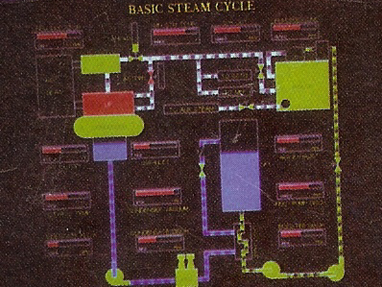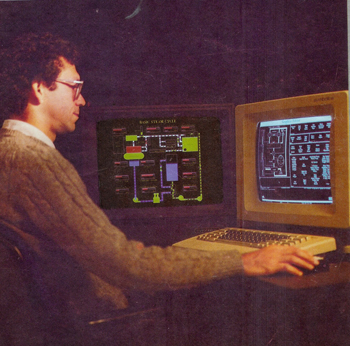
| Steamer |
The Steamer Project was an attempt to use then (early 1980s) state-of-the-art AI software and hardware to implement an intelligent computer-based training system. Our target system was the 1200 psi steam propulsion plant for US Navy destroyers. The Navy had comissioned a huge computer simulation of the behavior of such a steam plant. The interface to that simulation was a physical mock-up of the engineering spaces (boiler room and engine room) on a destroyer. Turning a valve in the simulated engineering space would send a signal to the simulation model to change the value of a flow variable. In the Steamer Project, we sought to provide an interactive graphical interface to this simulation model. Steamer permitted students to not only operate the steam plant, but to look inside it while it was in operation. We felt that this would make the construction of conceptual understandings much easier for students. We created almost 100 different views of the inner workings of the steam propulsion plant. In order to support the flexible creation of views we also built one of the first working object-oriented graphical editors. The project was conceived by Jim Hollan and Mike Williams at the Navy Personnel Research and Development Center. The principal contractor was as team at Bolt Beranek and Newman in Cambridge MA under the direction of Albert Stevens. (The UCSD influence was apparent, since Hollan was an instructor at UCSD and Williams and Stevens had both been grad students there.) Early in the project, my job was to work with subject matter experts (steam plant operators) to determine the content of the many views of the plant. Later I got into the programming side of things. The project was really wonderful because it provided such great resources. We used Symbolics Lisp Machines and this gave me a chance to acquire some expertise in Lisp programming. Steamer was eventually installed in three Navy schools (Newport RI, Great Lakes IL, and Coronado CA). While the impact on navy instruction was probably modest, the impact on interface design was considerable.
This image appeared on the cover of Summer 1984 issue of AI Magazine (Vol. 5, No.2). It shows project programmer Louie Weitzman interacting with the graphical editor. The system diagram for the basic steam cycle is shown on the screen to Louie's left. Publications: Hollan JD, Hutchins E L & L Weitzman. STEAMER: An interactive inspectable simulation-based training system. AI Magazine, 5:15-27, 1984. Hutchins E, Hollan JD & DA Norman. Direct manipulation interfaces. Human-Computer Interaction, 1, 311-338, 1985. Halff H, Hollan J & E Hutchins. Cognitive science and military training. American Psychologist, 41:1131-1139, 1986. Hollan JD, Hutchins E, McCandless TP, Rosenstein MB & L Weitzman. Graphical interfaces for simulation. In W. Rouse (Ed.), Advances in man-machine systems research (Vol. 3). Greenwich, CT: JAI Press, pp 129-163, 1987. Hutchins E. Metaphors for interface design. In: MM Taylor, F Neel & DG Bouwhuis (Eds.), The structure of multimodal dialogue.Amsterdam: North Holland, pp 11-28, 1989. |
